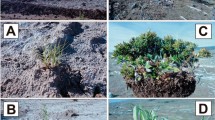Abstract
Endophytic bacterial communities of halophyte Salicornia europaea roots were analyzed by 16S rRNA gene pyrosequencing. A total of 20,151 partial 16S rRNA gene sequences were obtained. These sequences revealed huge amounts of operational taxonomic units (OTUs), that is, 747–1405 OTUs in a root sample, at 3 % cut-off level. Root endophytes mainly comprised four phyla, among which Proteobacteria was the most represented, followed by Bacteroidetes, Actinobacteria, and Firmicutes. Gammaproteobacteria was the most abundant class of Proteobacteria, followed by Betaproteobacteria and Alphaproteobacteria. Genera Pantoea, Halomonas, Azomonas, Serpens, and Pseudomonas were shared by all growth periods. A marked difference in endophytic bacterial communities was evident in roots from different host life-history stages. Gammaproteobacteria increased during the five periods, while Betaproteobacteria decreased. The richest endophytic bacteria diversity was detected in the seedling stage. Endophytic bacteria diversity was reduced during the flowering stage and fruiting stage. The five libraries contained 2321 different OTUs with 41 OTUs in common. As a whole, this study first surveys communities of endophytic bacteria by tracing crucial stages in the process of halophyte growth using high-throughput sequencing methods.



Similar content being viewed by others
References
Arahal DR, Ludwig W, Schleifer KH, Ventosa A (2002) Phylogeny of the family Halomonadaceae based on 23S and 16S rDNA sequence analyses. Int J Syst Evol Micr 52:241–249
Bodenhausen N, Horton MW, Bergelson J (2013) Bacterial communities associated with the leaves and the roots of Arabidopsis thaliana. PLoS ONE 8:e56329
Botella L, Santamaría O, Diez JJ (2010) Fungi associated with the decline of Pinus halepensis in Spain. Fungal Divers 40:1–11
Duan J, Yi T, Lu Z, Shen D, Feng Y (2007) Rice endophyte Pantoea agglomerans YS19 forms multicellular symplasmata via cell aggregation. FEMS Microbiol Lett 270:220–226
Hespell RB (2006) Serpens flexibilis: an unusually flexible bacterium. In: Dworkin M, Falkow S, Rosenberg E, Schleifer K, Stackebrandt E (eds) The Prokaryotes. Springer-Verlag, New York, pp 916–919
Isca VMS, Seca AML, Pinto DCGA, Silva AMS (2014) An overview of Salicornia genus: the phytochemical and pharmacological profile. Research Review. Daya Publishing House, New Delhi, Natural Products, pp 145–164
Li YH, Zhu JN, Zhai ZH, Zhang Q (2010) Endophytic bacterial diversity in roots of Phragmites australis in constructed Beijing Cuihu Wetland (China). FEMS Microbiol Lett 309:84–93
Lodewyckx C, Vangronsveld J, Porteous F, Moore ERB, Taghavi S, Mezgeay M, van der Lelie D (2002) Endophytic bacteria and their potential application. Crit Rev Plant Sci 21:583–606
Lundberg DS, Lebeis SL, Paredes SH, Yourstone S, Gehring J, Malfatti S, Tremblay J, Engelbrektson A, Kunin V, del Rio TG, Edgar RC, Eickhorst T, Ley RE, Hugenholtz P, Tringe SG, Dangl JL (2012) Defining the core Arabidopsis thaliana root microbiome. Nature 488:86–90
Mano H, Tanaka F, Nakamura C, Kaga H, Morisaki H (2007) Culturable endophytic bacterial flora of the maturing leaves and roots of rice plants (Oryza sativa) cultivated in a paddy field. Microbes Environ 22:175–185
Martín-García J, Espiga E, Pando V, Diez JJ (2011) Factors influencing endophytic communities in poplar plantations. Silva Fennica 45:169–180
Ozawa T, Wu J, Fujii S (2007) Effect of inoculation with a strain of Pseudomonas pseudoalcaligenes isolated from the endorhizosphere of Salicornia europea on salt tolerance of the glasswort. Soil Sci Plant Nutr 53:12–16
Preininger É, Zatykó J, Szücs P, Korányi P, Gyurján I (1997) In vitro establishment of nitrogen-fixing strawberry (Fragaria × ananassa) via artificial symbiosis with Azomonas insignis. In Vitro Cell Dev Biol 33:190–194
Romero FM, Marina M, Pieckenstain FL (2014) The communities of tomato (Solanum lycopersicum L.) leaf endophytic bacteria, analyzed by 16S-ribosomal RNA gene pyrosequencing. FEMS Microbiol Lett 351:187–194
Ryan RP, Germaine K, Franks A, Ryan DJ, Dowling DN (2008) Bacterial endophytes: recent developments and applications. FEMS Microbiol Lett 278:1–9
Schulz B, Boyle C (2006) What are endophytes? In: Schulz BJE, Boyle CJC, Sieber TN (eds) Microbial Root Endophytes. Springer-Verlag, Berlin, pp 1–13
Sheng HM, Gao HS, Xue LG, Ding S, Song CL, Feng HY, An LZ (2011) Analysis of the composition and characteristics of culturable endophytic bacteria within subnival plants of the Tianshan mountains, Northwestern China. Curr Microbiol 62:923–932
Shi Y, Yang H, Zhang T, Sun J, Lou K (2014) Illumina-based analysis of endophytic bacterial diversity and space-time dynamics in sugar beet on the north slope of Tianshan mountain. Appl Microbiol Biot 98:6375–6385
Sun L, Qiu F, Zhang X, Dai X, Dong X, Song W (2008) Endophytic bacterial diversity in rice (Oryza sativa L.) roots estimated by 16S rDNA sequence analysis. Microb Ecol 55:415–424
Zhao S, Li L, Li SH, Wang HF, Hozzein WN, Zhang YG, Wadaan MA, Li WJ, Tian CY (2015) Actinotalea suaeda sp. nov., isolated from the halophyte Suaeda physophora in Xinjiang, Northwest China. Anton Leeuw Int J G 107:1–7
Acknowledgments
This work was supported by the National Natural Science Foundation of China (No. 31300432) and the Foundation of Chinese Academy of Sciences (Nos. 2015-XBQN-B-16 and KSZD-EW-Z-022-03), and by the State Key Laboratory of Desert and Oasis Ecology (No. Y371162).
Author information
Authors and Affiliations
Corresponding author
Ethics declarations
Conflict of Interest
The authors declare that they have no conflict of interest.
Rights and permissions
About this article
Cite this article
Zhao, S., Zhou, N., Zhao, ZY. et al. High-Throughput Sequencing Analysis of the Endophytic Bacterial Diversity and Dynamics in Roots of the Halophyte Salicornia europaea . Curr Microbiol 72, 557–562 (2016). https://doi.org/10.1007/s00284-016-0990-3
Received:
Accepted:
Published:
Issue Date:
DOI: https://doi.org/10.1007/s00284-016-0990-3




